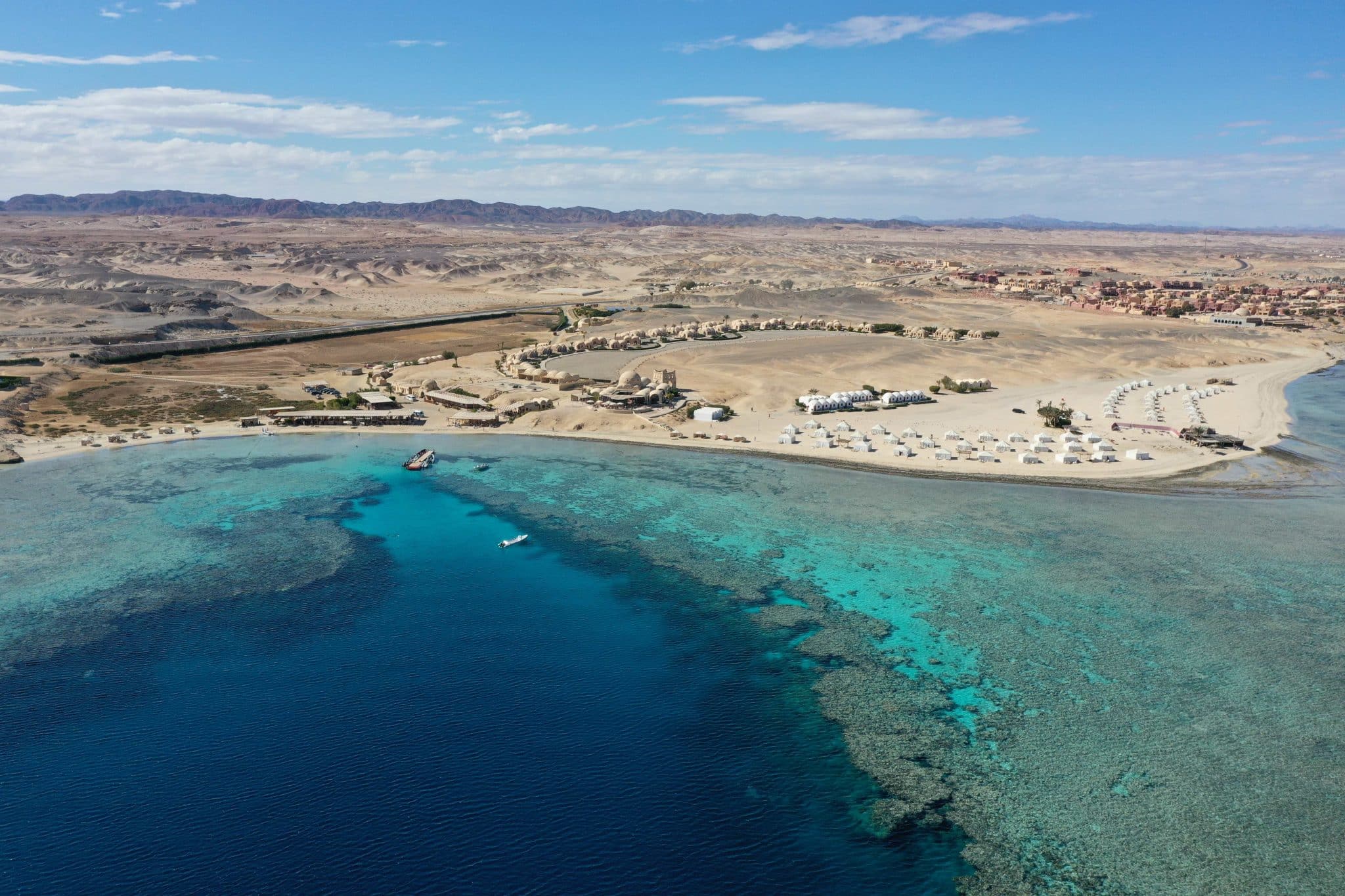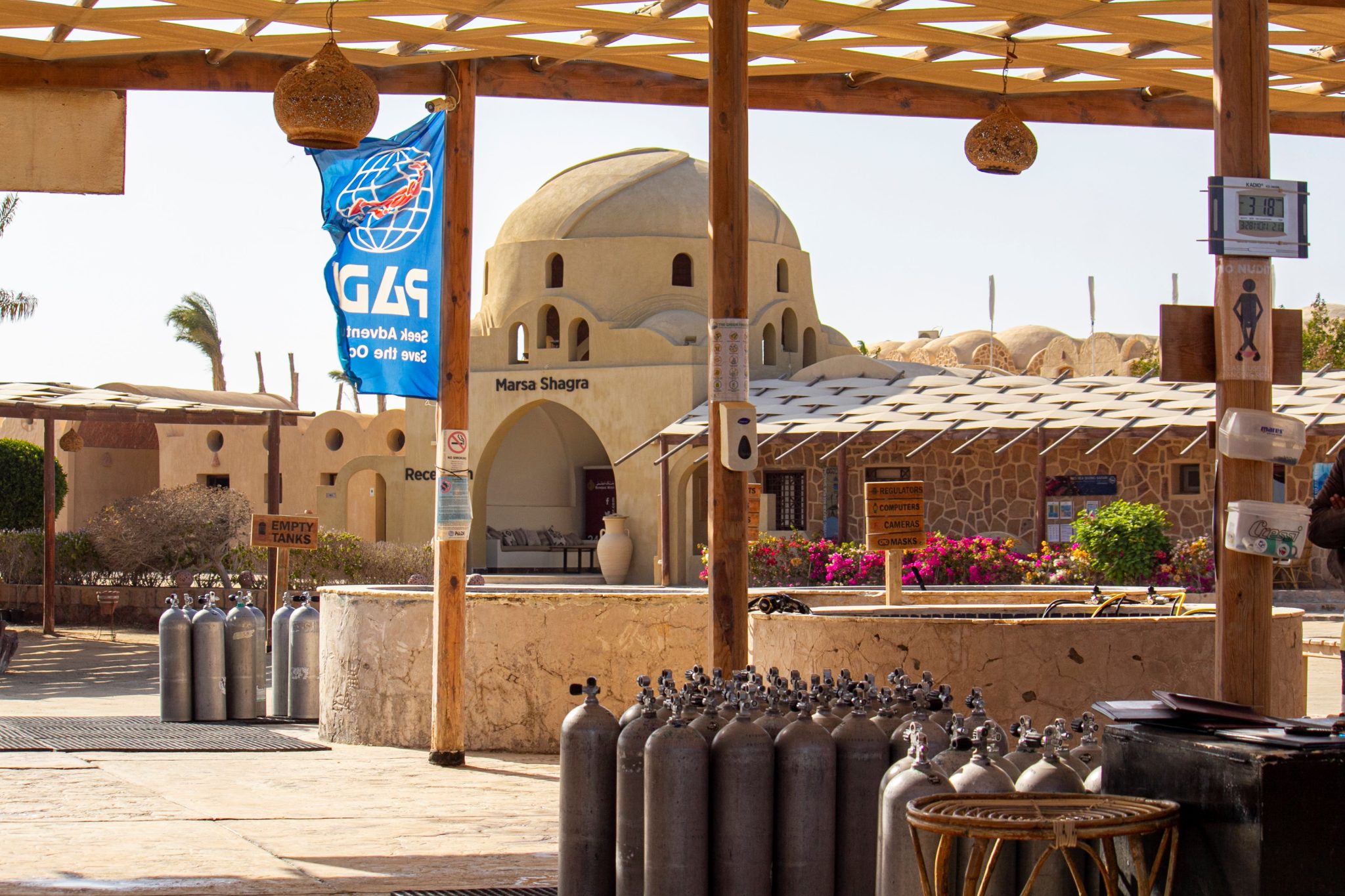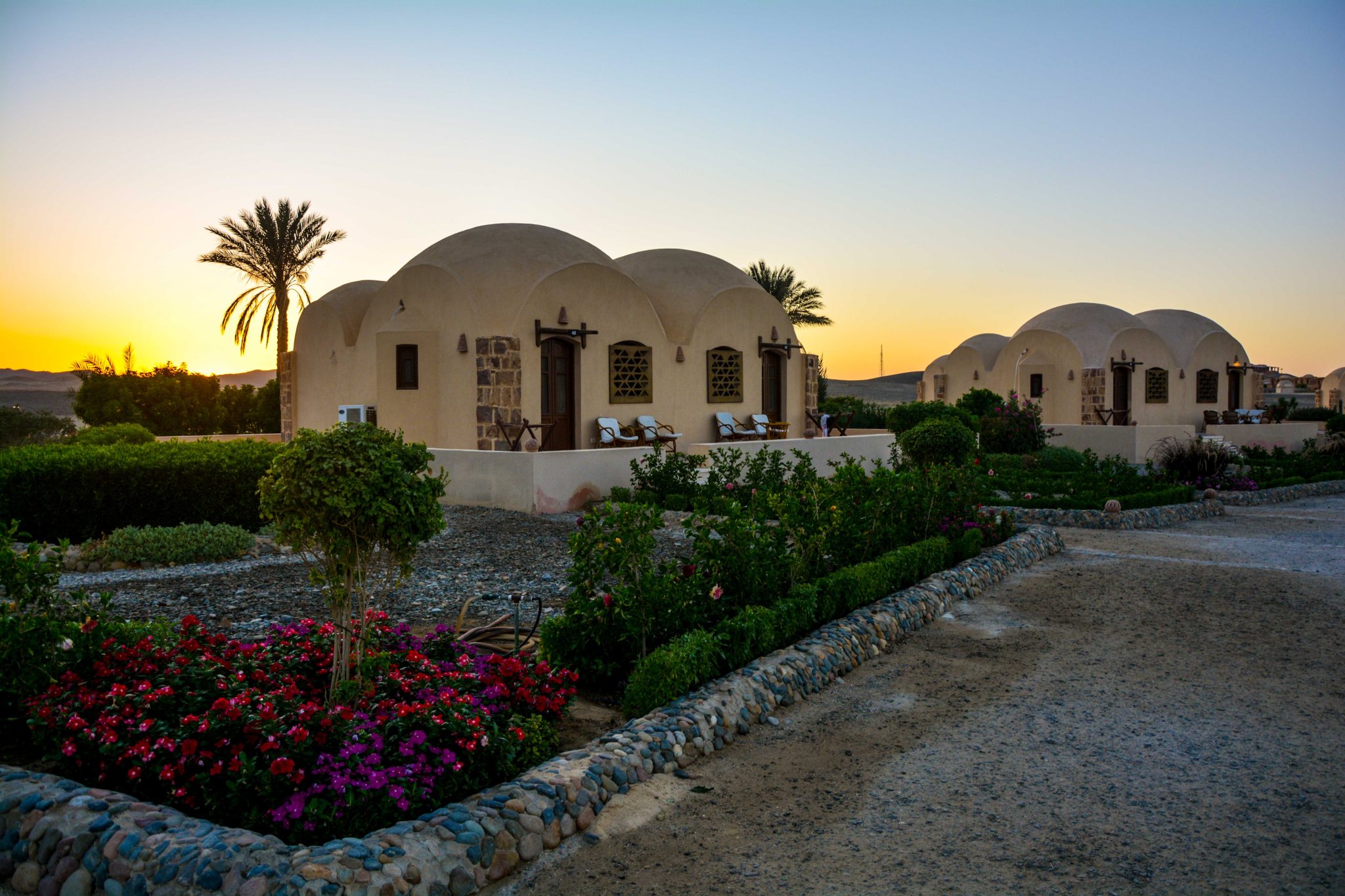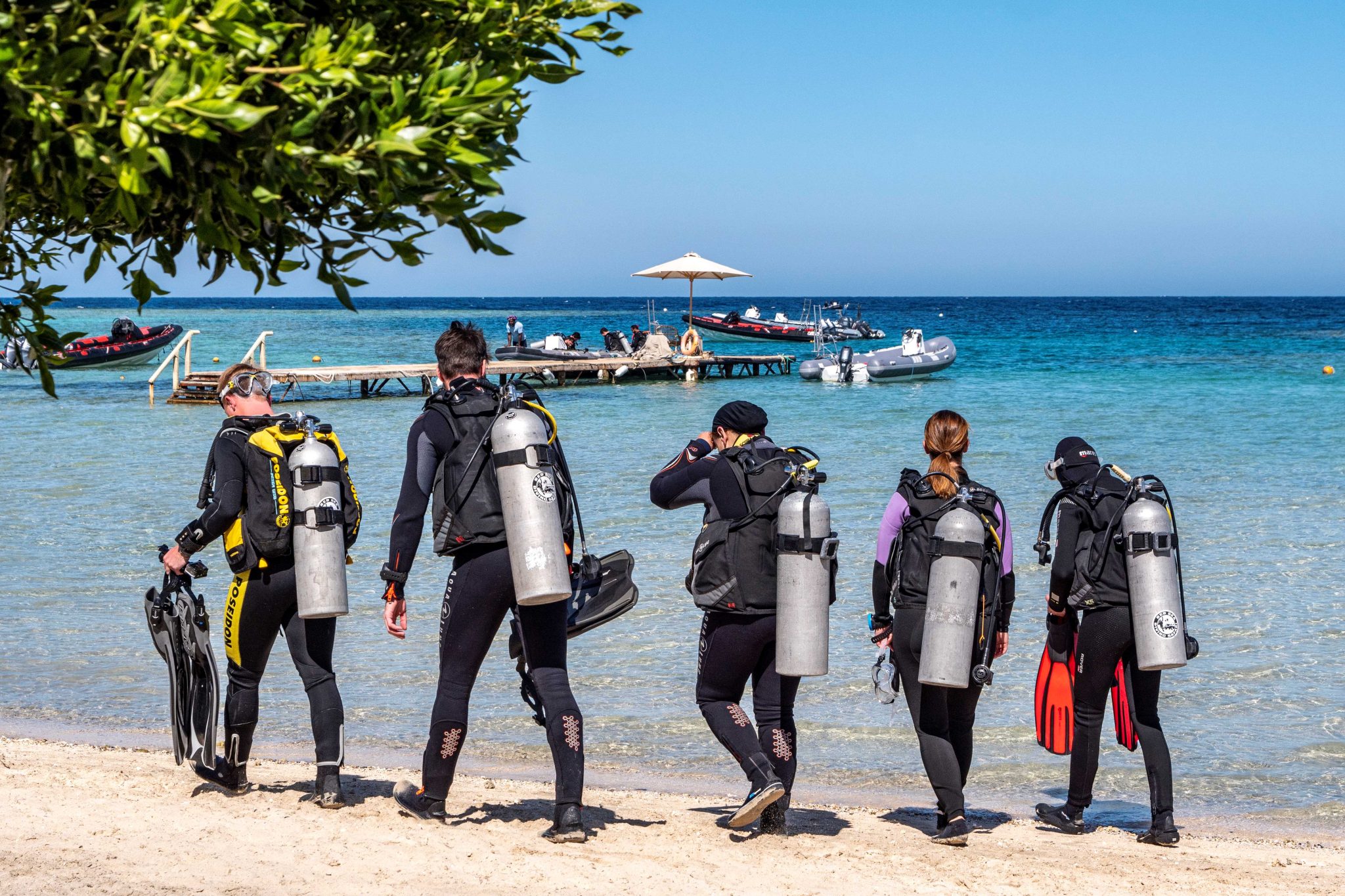Blogs
A day in the life of Marsa Shagra with Sea to Sky

Sea to Sky is delighted to collaborate with Red Sea Diving Safari (RSDS), encompassing three distinct diving “villages” – Marsa Shagra, Marsa Nakari, and Wadi Lahami. Each village possesses its own unique charm, and although they share a common ethos of sustainable and eco-friendly diving, they differ in many aspects.
Established by its founder, Mr. Hossam Helmy, in 1990, RSDS’s sustainable tourism model has been well-defined, catering to divers of all levels and experiences. The commitment to eco-friendly practices is a key aspect of the RSDS experience.

Traveling to RSDS can be achieved via two main airports: Marsa Alam Airport or Hurghada Airport. Marsa Alam is approximately a 40-minute drive from Marsa Shagra, while Hurghada entails a transfer of approximately 3 to 3.5 hours. Marsa Nakari is situated 40 km south of Marsa Shagra, and Wadi Lahami is 140 km away. RSDS facilitates all necessary transfers, ensuring a hassle-free experience with friendly drivers and comfortable vehicles, ranging from cars to minibuses based on the number of passengers. This commitment to convenience reflects RSDS’s dedication to providing a seamless and enjoyable journey for its guests.
I’ve been a dedicated visitor to RSDS for over a decade, a testament to the commendable operation they run. Each year, I make it a point to visit one of the villages, and on this particular trip in December 2023, it was heartening to encounter both familiar and new faces. The continuity of the team at RSDS, along with the addition of fresh members, is a testament to the sense of community fostered there. The warmth and friendliness extended to me upon arrival always make me feel like a long-lost friend, reinforcing the familial atmosphere that RSDS cultivates.
My journey began with a visit to a supplier in Hurghada, and I had prearranged both the transfer and accommodation through the head office. Guests like myself are required to use agents for bookings, ensuring a standardized cost structure. Despite not being able to book directly with RSDS, the pricing clarity remains consistent across agents.
Promptly at 10am, my transfer arrived, allowing me to embark on the journey south to Marsa Alam. The drive itself was uneventful but pleasant, offering a straightforward route. A scheduled rest break en-route provided an opportunity to grab a coffee and a bite to eat, making for a smooth and enjoyable travel experience.
Upon my arrival at Marsa Shagra, I was dropped off at the main reception just after 1pm by the driver. Taking charge of unloading my bags, I proceeded to check in, which turned out to be a straightforward process. The reception efficiently gathered my passport details and accommodation voucher. As a Tour Operator (TO), we provide guests with a voucher confirming booking details, and this was handed in at the reception. Once the formalities were completed, I received my keys.

Assisted by one of the staff members, we made our way to my chosen accommodation. Marsa Shagra offers a diverse range of lodging options, including Superior Deluxe, Premium Deluxe, and Deluxe chalets (my choice for this visit). Other options include huts, Royal Tents, standard tents, and accessible chalets. The Royal tent, positioned on the shore, stands out as a popular choice, offering a light and breezy ambiance that truly captures the essence of Egypt. If you’re interested, I can provide more details about the various accommodation options available.

Notably, Marsa Shagra provides an environmentally conscious amenity — an unlimited number of cold water dispensers distributed throughout the villages. Guests are encouraged to bring their own water bottles for free refills whenever needed, reflecting RSDS’s commitment to sustainability and guest well-being.

Once settled in, with a quick shower and dive kit organized, it was time to make my way to the equipment room near the reception at Marsa Shagra. This is where guests check in for their prearranged diving packages, typically agreed upon with their Tour Operator (TO). The most popular choice is the 5-day unlimited house reef diving package, though there’s flexibility for daily unlimited diving as well. There’s a diving package to suit every preference.

Upon arrival at the equipment room, you complete mandatory forms required by PADI and RSDS. You can collect any necessary weights or equipment, get assigned a locker number, and then head over to the dive shade. Managed by Shazli and an exceptional team, including Shekaa, the dive shade staff are always welcoming, cheerful, and highly professional. Shekaa even assisted me in unpacking my dive gear and organizing it in the allocated locker, providing a helpful touch to the overall experience.
The dive shade, conveniently located opposite the equipment room, is equipped with all the amenities and facilities a diver might need. This includes changing rooms, clearly labelled clean tanks for equipment, fresh water, and more. The layout is well-designed and well-thought-out, contributing to a seamless diving experience.

It’s worth noting that all guests are recommended to attend the daily morning Orientation talks at the dive office at 9am. These talks provide detailed information about RSDS Marsa Shagra, covering procedures, offshore excursions, diving operations, night diving, reef topography, speed boats, dive profiles, and more. In addition and as part of the diving package, two orientation dives are included accompanied by a dive guide. It’s a valuable session for understanding the workings of RSDS.
One of the standout features of RSDS, particularly at Marsa Shagra and Marsa Nakari, is the concept of unlimited diving. The flexibility to grab a tank and explore the underwater world at your own pace, either with a buddy or using the buddy board to find one, adds to the appeal of the RSDS experience. It’s a great way to make new friends and fully immerse yourself in the diving community.

After my visit to the equipment room, I made my way to the restaurant for lunch, passing by the cafeteria and dive office where I exchanged greetings with Basta and Marie, who, alongside Maher, efficiently manage the dive operation with a focus on safety and professionalism.
The restaurant serves breakfast, lunch, and dinner in a buffet style, and I was truly impressed by the extensive choices available. The spread included around 20 different salads, 10 hot dishes, assorted bread, soup, and a variety of fresh fruits. The culinary offerings at RSDS cater to diverse dietary needs, accommodating intolerances as well as providing options for vegans and vegetarians. No one would leave hungry with such a variety on offer.

After a satisfying lunch, I leisurely made my way to the cafeteria for a Turkish coffee. Soft drinks, teas, and regular coffees are complimentary, though diet drinks and Turkish coffees come with a separate charge. Following the delightful Turkish coffee experience, I headed to the dive shade to gear up. As a certified Self Reliant instructor, I had the flexibility to dive on my own. For the day, I aimed to complete a check dive and ensure all my equipment functioned properly.
Equipped with my stage, two masks, two computers, and two DSMBs, I added my name to the diving board, signalling to the staff that I had entered the water and indicating the expected time of my return. The water temperature was a comfortable 25 degrees, considering it was December. The highlight of Marsa Shagra undoubtedly lies in its house reef. The reef’s profile, running from North to South with an entry through a sandy sloping bottom, is ideal for confined courses. As the sandy bottom gradually deepens, you’re compelled to dive, and the healthy reef teems with millions of beautiful fish and marine life. My first underwater encounters included a free-swimming peppered moray and a turtle, making it a truly magical experience.
The profiles at Marsa Shagra is such that with the unlimited diving package you have use of the Zodiacs, so can opt for 6 different profiles of diving, whether it be shore / shore, Zodiac / shore or Zodiac / Zodiac, on either the North reef or South Reef.
After completing my check dive, I emerged from the water, removed my name from the board, and rinsed all my gear. Once I stored my equipment in the locker and hung up my wetsuit, I headed to one of the hammocks for a well-deserved rest, accompanied by the soothing sound of the sea lapping against the shore—pure bliss. A short nap later, I went to the dive centre to sign up for the 6am Elphinstone trip. Afterward, I returned to my chalet for a shower and change of clothes, then made my way to the chill-out area near the dive shade to socialize with fellow guests and enjoy a refreshing Stella beer, a fitting reward for completing my check dive.

Dinner, starting at 6:30pm, proved to be another culinary delight. Marsa Shagra offers themed main courses each night, and on this particular evening, it was Egyptian night. Freshly grilled chicken, koftes, and a variety of sides graced the menu. The real star, however, was the dessert selection—mind-blowing in terms of variety, flavours, and presentation. Satisfied and anticipating the Elphinstone trip the next morning, I retired to my chalet.
The next day began early at 5 am. After a cup of coffee, I headed to the dive shade to prepare my gear for the Elphinstone trip. Our guide, Kareem, also the freedive instructor and a friend I’ve known for years, led the trip. Kareem, affectionately known as the “shark whisperer,” provided a thorough briefing on the trip, the dive profile, and how to behave in the presence of white tip sharks. A 15-minute boat ride took us to Elphinstone, where, after checking the current, we embarked on an exhilarating and safe dive with encounters with white tip sharks. We returned to Shagra in time for breakfast.

Breakfast, like lunch and dinner, was served buffet-style, offering fresh eggs cooked to your liking, felafel, foul, pastries, and fruits. The food and variety were impeccable.
In summary, my day at Marsa Shagra, a diving eco-village built for divers by divers, was a slice of heaven in southern Egypt. With excellent amenities, a dedicated staff, and a commitment to sustainable diving, it’s a unique and enriching experience. If you’re a diving enthusiast, Marsa Shagra and RSDS offer an unparalleled opportunity to explore the stunning and healthy reefs of the Red Sea. Don’t just take my word for it—go and experience it yourself and revel in the beauty of Marsa Shagra and RSDS.
Join Sea to Sky and embark on new diving adventures! Visit www.myseatosky.co.uk for more information.
Blogs
Alonissos: The complete diving destination (Part 1)

In June we were incredibly fortunate to be invited to dive in Alonissos, a small Greek Island in the Sporades island chain located in the North Aegean Sea. While I have long been a big fan of the Greek Islands as a great holiday destination, I had not had the opportunity to do any diving on previous visits and Mike and I were extremely excited to see what Alonissos had to offer both above and below the surface!

The Sporades are easily accessible via the airport in Skiathos (the first island in the chain), which is served by Jet2 flights from all major UK airports from May through October. Numerous ferries and charter boats make island hopping from Skiathos Town a breeze. After an hour boat ride, the picturesque port of Patitiri was a wonderful introduction to Alonissos, where we were met by our gracious hosts Kostas of Albedo Travel and Dias of Alonissos Triton Dive Center. Mike and I were delighted to be staying at the Paradise Hotel, aptly named for its stunning views over the sea and great location for walking to the waterfront.

Alonissos is beautifully situated in the National Marine Park of Alonissos and the Northern Sporades, the largest marine protected area in Europe. The surrounding seas offer fabulous marine life, including incredibly rare species such as the Mediterranean monk seal. They boast deep walls covered in gorgonians and sponges, stunning topography with caverns, swimthroughs and pinnacles, and the first accessible ancient shipwreck from 500BC!

In locations where historical sites have been reported, the waters are largely restricted, but with collaboration between government, underwater archeologists and dive centres, incredible underwater museums are being created for a truly unique diving experience. Alonissos is home to the first of these, the Ancient Shipwreck of Peristera Accessible Underwater Archeological Site. The chance to dive into history (along with reports of healthy reef life and amazing underwater topography) meant Mike and I were keen to get in the water.

Our introduction to the diving around Alonissos was at the Agios Georgios Pinnacles, in the channel between Alonissos and Skopelos. This fantastic site was named “The Chimney,’ and proved to have a huge amount to see. We got to a decent depth here (over 25m), and marvelled at a colourful reef wall with a wonderful swim through whose rocky walls were absolutely covered with life. As well as brilliant topography there was no shortage of macro life here. We saw numerous nudibranchs, five different species in total. The second dive at Mourtias reef nearby was a shallower dive along a nice wall with lots of crevices. Several moray eels and grouper called this site home. We enjoyed looking in the crevices for lobster and smaller benthic life, such as cup corals and tunicates.

Our itinerary allowed us two dives a day with afternoons left to explore the island with our hire car and evenings to enjoy the famous Greek hospitality. This proved to be a lovely mix of in-water and land based diversions.

The next days diving to the Gorgonian Gardens and Triton’s Cave was to be even better! These two stunning sites are nothing short of fabulous. The Gorgonian Gardens was a deep wall near to the Agios Georgios islands. The ever-present currents in this deep channel meant that the sea life was amazing … the namesake Gorgonian sea fans dotted the wall at a depth of 30 to 50 meters, getting ever larger the deeper we went. Above 30m was by no means less beautiful, with sponges, corals, scorpionfish, moray eels and some rare and colourful nudibranchs.

The second shallower dive of the day was to Triton’s Cave or the Cavern of Skopelos, on the east side of that island. The spectacular rock formations had wild striations both above and below the water making a truly epic topography. The cavern entrance was at 14m, and big enough for a buddy pair, winding up to 6m and passing two beautiful windows out into the blue. Emerging from the cavern, the light at the shallower depths and the incredible rock formations made for a fantastic gentle swimming safety stop and we all surfaced by the boat with massive grins.

Check out our next blog :Alonissos: The complete diving destination (Part 2)” to hear about our amazing dive on the 2500 year old Peristera Wreck!
Thanks to:
Alonissos Triton Dive Center https://bestdivingingreece.com/
Albedo Travel https://alonissosholidays.com/activities/
Paradise Hotel https://paradise-hotel.gr/
Alonissos Municipality https://alonissos.gr/en/
Blogs
Mamma Mia! Diving Skopelos (Part 2)

Our second days dive itinerary was to the famous Christoforos wreck! This is arguably the best dive in Skopelos and though only open to divers with deep diving experience, this 83m long wreck is well worth the visit.
The Christoforos sits in 43 meters of water with the deck at 32 to 35 meters. A 30m dive can give an impressive view of the wreck, though such a large wreck needs a few dives to truly do it justice. Given its ideal location just a 2 minute boat ride from the dive centre dock it is an excellent first dive of the day. The sheltered site is also diveable in all but the absolute worst weather so although deep, the water is usually clear with little to no current making it a very pleasant dive. The site is superb for technical diving and a great training site for the Tec 40 and 45 programs, offered by Skopelos Dive Center.

The Christoforos wreck was originally a collier ship built in 1950 at Grangemouth shipyard under the name “Thomas Hardie”. In 1976 she joined the Greek merchant fleet as “Christoforos”. On the 2nd of October 1983 the Christoforos was carrying 2600 tonnes of cement from Volos to Piraeus Port. During the voyage the weather turned, resulting in the ship developing a 7 degree list, whereby she changed course for safe anchorage at Panormos, Skopelos. The ship reached Panormos at 16:00 with a list of 17 degrees and water ingress to No. 1 hull. Though attempts were made to right the vessel, the crew were ordered to abandon ship at 22:00. The captain, lieutenant and the quartermaster remained to try and save the ship, but had to abandon the attempt themselves and the Christoforos finally sank at 05:30 on 3rd October 1983. She now sits upright in 43 meters of water less than 200m from shore in Panormos.

Diving has only been allowed here since 2018, so the wreck is very well preserved and a real treat to dive. Permission to dive here was granted by the authorities after lots of incredibly hard work by the Skopelos Dive Center staff. Having a fantastic wreck in such an amazing location and in excellent condition is a real privilege.

Of all the sites in Skopelos this was the site Mike and I were most keen to experience. Having kitted up and zipped across the bay to the mooring, we left the surface and followed the descent line until the wreck emerged spectacularly from the blue at 15m. She is a big and beautiful wreck, sitting as though calmly continuing her journey along the seabed. With most of her original features still intact there were points of interest everywhere, including the anchors, winches, ships telegraphs, the wheel and RDF antenna.

We found that aquatic life had colonised the ship, with schools of fish, electric blue nudibranchs, a large moray eel and the resident scorpionfish lurking inside the bridge. The Christoforos was truly a stunning wreck and despite maximising our time at depth we eventually had to say our goodbyes and begin the slow and steady return to the surface.

After a superb morning dive we had the afternoon to do a little sightseeing of the island, with a trip to the church of Agios Ioannis Kastri made famous by the blockbuster movie “Mamma Mia!”. Mike and I spent a happy afternoon pootling around in our little hire car before meeting up with Lina from Skopelos Dive Center. An underwater archeologist as well as a dive professional, Lina had offered to show us a rather special attraction, the Christoforos shipwreck Digital Spot public information and awareness centre.

A fantastic initiative made possible from the collaboration of the government and hard work of the staff at Skopelos Dive Center is the “Digital Spot” in Agnontas port. This information center has a number of displays on the history of the Christoforos wreck, the process by which the wreck was allowed to be opened to the public for diving tourism, other sites of historical interest in the area, a video of the wreck and the best bit, a virtual reality dry dive experience! The beauty of the VR system is that non diving members of the family can see what you have seen on the wreck, or you can see areas that you may not have explored during the dive due to time or depth limitations. It was a truly immersive experience and a great addition to the dive itself.

After a wonderful day we celebrated our last evening on the island with an exquisite meal in Skopelos Town with fabulous views over the town and bay, washed down with the excellent local wine. The lamb with lemon and potatoes was a meal which I could happily eat every day for the rest of my life!

Skopelos is an island that truly has it all. The diving is excellent, the landscape is beautiful with plenty of non diving activities, the locals friendly and the food and drink superb. Given how accessible it is as a holiday destination it has avoided becoming overcrowded and even in peak season offers a fun yet relaxing atmosphere. We highly recommend giving Skopelos a visit. We will certainly be back again!
Thanks to:
Municipality of Skopelos (https://skopelos.com/)
Skopelos Dive Center (https://sporadesdiving.gr/)
Ionia Hotel (https://www.ioniahotel.gr/en)
Dolphin of Skopelos (https://dolphinofskopelos.com/)
Ta Kymata restaurant (@takymata)
The Muses restaurant (https://www.facebook.com/TheMussesMousses/)
Aktaiov resturant (https://skopelos.com/listings/aktaion-taverna/)
-

 Blogs2 months ago
Blogs2 months agoDiving With… Nico, Ocean Earth Travels, Indonesia
-

 News1 month ago
News1 month agoMurex Bangka Announce New Oceanfront Cottages & Beachfront Dining
-

 Blogs2 months ago
Blogs2 months agoA new idea in freediving from RAID
-

 Marine Life & Conservation1 month ago
Marine Life & Conservation1 month agoIceland issue millionaire whale hunter a licence to murder 128 vulnerable fin whales
-

 Marine Life & Conservation2 months ago
Marine Life & Conservation2 months agoThe Shark Trust Great Shark Snapshot is back
-

 News3 months ago
News3 months agoCharting New Waters; NovoScuba Goes Global with the Launch of their Revolutionary Dive Training Agency!
-

 Gear News1 month ago
Gear News1 month agoNew Suunto Ocean – a dive computer and GPS sports watch in one for adventures below and above the surface
-

 Marine Life & Conservation Blogs2 months ago
Marine Life & Conservation Blogs2 months agoBook Review: Plankton















